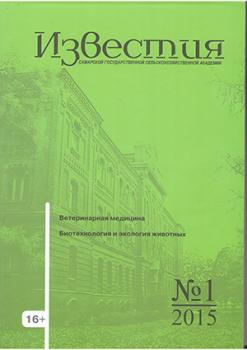p.g.t. Ust'-Kinel'skiy, Samara, Russian Federation
The purpose of research is the resistance increasing of the chinchillas organism to the representatives of pathogenic and conditionally-pathogenic microbes with non-infectious pathology for the gastrointestinal tract. Based on the purpose of the study, were as follows – extruding and identification chinchillas contained family transient and resident representatives microbiocenosis; by morphological, tincrial, cultural, biochemical and serological properties of these microbes. The experimental group, chinchillas with non-communicable disorders of the gastrointestinal tract (gastroenteritis and colitis) in fecals resident microorganisms Enterococcus faecalis – КОЕ 2.85h104±0.23, Peptococcus niger – 3.64h105±0.33, Peptostreptococcus anaerobius – 3.74h104±0/52, Lactobacillus delbrueckii – 2.84h102±0.53, Bifidobacterium bifidum – 3.16h102±0.46, Es-cherichia coli – 2.67h105±0.53, Serratia marcescens – 2.95h104±0.13, Bacteroides fragilis – 2.57h103±0.12, Prevotella bivia – 4.21h103±0.24 were identified. Among the transient microorganisms were identified Staphylococcus epidermidis and S. saprophiticus, Streptococcus rattus and S. cricetus, Enterobacter cloacae, Klebsiella oxytoca, Citrobacter diversus, Salmonella enteritidis, and Yersinia enterocolitica, Proteus vulgaris, Bacillus cereus, B. subtillis, Clostridium sporogenes, C . ramosum, C. difficile, Helicobacter pylori, Campylobacter coli. In conclusion: Microbiocenosis healthy chinchillas includes automicroflora occupying a certain ecological area in the animal organism. With the development of non-contagious disease of the gastrointestinal tract in chinchillas reduces the number of automicroflora and its situation replaces transient and opportunistic pathogenic microorganisms, penetrating into the body of animal alimentary and fecal-oral. It is important to use the effective probiotics for chinchillas gastrointestinal tract.
microbiocenosis, chinchilla, enterobacteria, enterococci, bacteroides
Пептококки и пептострептококки в ассоциации с другими микробами вызывают гнойно-воспали-тельные болезни различной локализации, обитают на слизистых полости рта, кишечника, верхних дыхатель-ных путей и мочеполового тракта.
Энтеробактерии вызывают кишечные инфекции и некишечные, оппортунистические инфекции, вы-зываемые условно-патогенными бактериями различных родов семейства Enterobacteriaceae [1].
Вирусная инфекция в период становления клеточных и гуморальных звеньев неспецифической ре-зистентности и иммунной системы создаёт благоприятные условия для активизации патогенных и условно-патогенных бактерий и микромицетов [2, 3].
Условно-патогенные микроорганизмы, представители резидентной и транзиторной микрофлоры макроорганизма оказывают болезнетворное воздействие на организм изученных хорьков, кошек и собак [4, 5]. Питание животных, при этом, является одним из самых значимых экологических антропогенных фак-торов для макроорганизма, который может привести к качественным и количественным нарушениям видово-го спектра микробного ценоза [6].
При дисфункции микробиоценоза у мелких домашних животных часто диагностируются кератомико-зы и поверхностные дерматомикозы [7].
В ходе дисбаланса микробиоценоза желудочно-кишечного тракта у козлят происходит снижение ре-зидентной облигатной анаэробной микрофлоры [8].
В настоящее время в России у граждан большой популярностью пользуются шиншиллы, у которых часто, как и у других грызунов, проявляется незаразная патология желудочно-кишечного тракта [9]. В связи с этим были проведены исследования резидентной и транзиторной микрофлоры шиншилл, содержащихся у жителей г. Самара.
Цель исследований – повышение резистентности организма шиншилл к представителям патоген-ных и условно-патогенных микробов при незаразной патологии желудочно-кишечного тракта.
Задачи исследований – выделение и идентификация у шиншилл видового состава микрофлоры желудочно-кишечного тракта по морфологическим, тинкториальным, культуральным, биохимическим и серо-логическим свойствам.
1. Vorobiev, A. A. Atlas of Medical Microbiology, virology and immunoloogy / A. A. Vorobiev, A. S. Bykov, M. N. Bojchenko [et al.]. - M. : Medical information Agency, 2007. - P. 40-45.
2. Ermakov, V. V. Microorganisms complicating panleucopenia of cats in the conditions of the Samara region // Bulletin of the Samara State Agricultural Academy. - 2015. - №1. - P. 50-56.
3. Ermakov, V. V. Microbiocenosis burrows under non-contagious disease of the gastrointestinal tract // Zootechnical science in the context of contemporary challenges : coll. of art. - Kirov, 2015. - P. 101-105.
4. Ermakov, V. V. Pathogenic and pathogenic microbes in microbiocenosis ferrets (ferret) under the conditions of the Samara region // Bulletin of the Samara State Agricultural Academy. - 2014. - №1. - P. 29-35.
5. Ermakov, V. V. The resident and transient microflora of stray cats and dogs in the Samara region // Bulletin of the Samara State Agricultural Academy. - 2013. - №1. - P. 15-19.
6. Ermakov, V. V. Microbiological identification microbiocenosis and immune status in laboratory rodents when fed genetically modified feed them // Bulletin of the Samara State Agricultural Academy. - 2012. - №1. - P. 38-43.
7. Ermakov, V. V. Microbiological diagnosis ceratomicoses and surface dermatomycoses have small pets // Bulletin of the Samara State Agricultural Academy. - 2011. - №1. - P. 35-38.
8. Ermakov, V. V. The immune status and identification of enterobacteria stool culture Saanen goats // Bulletin of the Samara State Agricultural Academy. - 2010. - №1. - P. 11-14.
9. Chinchillas. Description, types and content chinchillas [Electronic resource]. - URL: http://fauna.dobro-est.com (date accessed: 24.12.2015).





